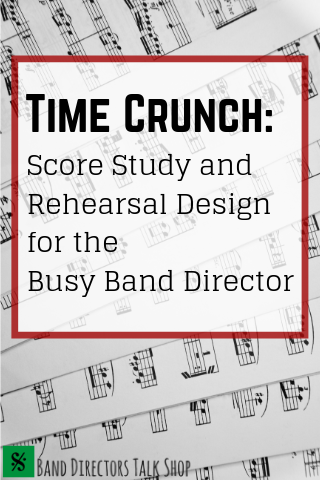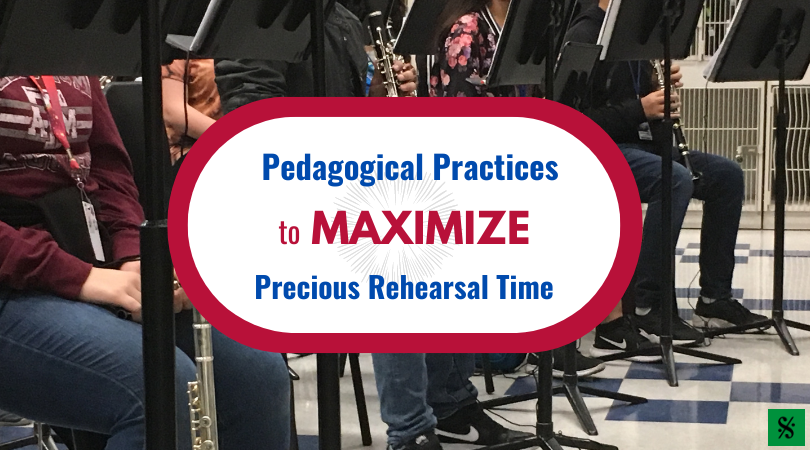The life of a band director is busy – sometimes insanely so. We’re responsible for rehearsals, logistics, assessments, and tasked with making sure our work follows educational standards and displays measurable growth. On top of those things which are related directly to teaching we’re also responsible for committee work, service, supervision/advising of student organizations, lunch duty, and/or a myriad of other tasks to ensure the educational institution for which we work runs smoothly. With all of these things to stay on top of, it would be logical to assume that we are incredibly efficient in how we prepare to teach and conduct. This is all too often not the case.
Two of the most important parts of our job – score study and rehearsal design – are often treated separately, creating inefficiencies in our use of time. The purpose of this article is to explore ways in which we can link score study and rehearsal design to increase efficiency and create positive outcomes both for our personal time use and for our students’ learning. This will be done by briefly discussing concert programming and moving on to a discussion about score study/chunking and rehearsal preparation, all while presenting several ways to link assessment to score study and rehearsal design to further increase efficiency and positive learning outcomes.

Before a discussion of score study and rehearsal design can be had, one must consider what will be studied. While programming is an intensely personal process there are several aspects that should be thought about. When programming, one must have two groups of people in mind: the ensemble and the audience. While a commitment to programming based on the ensemble is important, the enjoyment of the audience, in regards to the finished product, must be balanced.
When programming with the ensemble in mind, consider:
- Current Student Ability vs. Potential:
- Choose music that gives your students the opportunity to improve. Be careful about programming music that is so far beyond their reach that you set them up for failure.
- Think about programming using:
- Themes – Seasons, Cultures, Assessments/Contests/Festivals, etc.
- Long-term Goals – What musical skills are you trying to help your students improve upon, and how can you use the literature to do that?
- Student Requests – You don’t have to program everything the students want to play, but doing so once in a while can be good for student morale.
- Balance student enjoyment with pedagogical value
- Students need to enjoy what they’re playing but also need to be learning. Choose music that can accomplish both tasks while continuing to improve your overall program.
When programming with the audience in mind, consider:
- Music the audience is comfortable with:
- This might include movie or pop music but could also include repertoire based on folk songs or cultural melodies/rhythms.
- Music that will push their boundaries. Part of our job is educating the audience along with our students, so music showcasing mixed-meter, atonality, or extended techniques should be mixed in.
- Most importantly, pick music that will sound great.
The balance between programming for the ensemble and for the audience can be difficult to achieve. Likely, each program will strike a slightly different balance between the two groups but it is no less important to attempt to strike this balance.
Now that the literature to be studied is decided it is important to think about the rehearsal process in an organized way. The rehearsal process can be thought about in (at least) three types of rehearsal groupings: Reading Rehearsal(s), Teaching Rehearsals, and Polish/Cleaning Rehearsals.
The reading rehearsal is the first rehearsal on new literature. The purpose behind it is to show the ensemble the challenge that lies ahead of them. It gives the band director the opportunity to introduce new concepts (abnormal time or key signatures, odd instrumentation, etc.) as well as to further develop any teaching or assessment plans that have been formed in advance. Score study for the reading rehearsal, at the minimum, involves marking cues, large key areas, time signatures, and identifying sections in which your ensemble might have trouble. Beyond that, personal preference plays a large role in what must be marked in order to feel comfortable. Following the reading rehearsal, the band director can solidify and/or re-work curricular plans for teaching the music in time for the concert.
Next are the teaching rehearsals. The primary purpose of these rehearsals is to teach the music! Break the music into chunks, and have these chunks planned in advance in such a way that a consistent amount of each piece is practiced during each rehearsal leading up to the performance. Typically, one would start by teaching the first chunk in the first rehearsal. The next rehearsal, teach the last chunk after reviewing the first. The third rehearsal, review the last chunk, teach the second chunk, and then practice combining the first and second chunks. Continue on in this way until the chunks meet in the middle. Depending on the musical work being studied, one might start in the middle and move out, or skip around the work due to pedagogical reasons (similar difficult sections, keys, etc). Score study for each teaching rehearsal involves the in-depth study and marking of each chunk to be rehearsed. Here, the conductor should be paying attention to individual vertical harmonies, articulations, smaller forms, consistent musical ideas, and individual interpretation. Additionally, score items pertaining to technique, such as cues, dynamics, and shaping should be codified and marked.
The primary reason for planning chunks in advance is the ease of building in assessments to the rehearsal process. Knowing what will be rehearsed a couple of rehearsals in advance allows for the assigning of practice homework, the organization of playing tests/assessments, and builds in accountability for the students. Once they know you are serious about that homework, you’ll notice they come to rehearsal more prepared, and rehearsals become more efficient. It follows that the literature you’re able to program changes and the performance achievement of the whole ensemble starts to improve. In addition, having consistent assessments will improve your standing with administrators and give you the ability to track progress in a measurable and consistent way. Finally, consistent playing tests throughout an academic year provide students with a portfolio of their music and your comments for improvement, both of which give them a sense of progress and help them develop a plan to become a better band musician.
Once each chunk of music has been learned and the performance is approaching, it is important to include a couple of rehearsals to polish what has been learned and put the finishing touches on the pieces to be performed. To prepare for the first polish rehearsal, make a recording of a recent run through for each piece. Listen back to those recordings and carefully note inconsistencies and other issues that you hear. Make a list of those performance problems and use that to guide the preparation of the next rehearsal plan. Repeat this process for each polish rehearsal you hold. Assessment activities can be built into polish rehearsals by using the list of issues that need addressing to formulate homework assignments, create playing tests, and to generally increase student accountability.
Having a sensible and organized approach to score study and rehearsal design can benefit the band director in several ways. Time spent overall between score study and rehearsal design can be lowered as the two projects become more linked. Students can be more easily held accountable because they have clear expectations in front of them. Administrators will appreciate that assessments are being held consistently, are both formative and summative, and that consistent growth can be shown. Perhaps most importantly, students will recognize their musical growth and over time performance quality will increase. For these reasons (and many more), taking a sensible, organized, and inclusive approach to score study and rehearsal design can help take your band program to the next level.
Christopher Dobbins is the Director of Instrumental Activities at Washington and Lee University, where he conducts the University Wind Ensemble, University Orchestra, and teaches conducting and music education courses. Prior to his appointment at WLU, he served as Director of Bands at Sul Ross State University, where he conducted the Wind Ensemble and taught courses in conducting and music education. Prior to teaching at SRSU, he was Instructor of Brass at Our Lady of the Lake University, Instructor of Trombone at Texas A&M International University, and Director of Bands at Saint Mary’s Hall College Preparatory School. Chris earned the Bachelor of Music in Education and in Trombone Performance from Hastings College, the Master of Music in Trombone Performance from the University of Utah, and is completing requirements for the Doctor of Education in Music Education from the University of Georgia. Chris is active as a conductor and clinician, and is an Educational Clinician for Jupiter Instrument Co. He resides in Lexington, VA with his beautiful wife, daughter, and houseful of furry children.
Related Reading:
Make Your Mark: Steps Toward Efficient Score Study (Quick Tip)
Choosing Literature for Success at Contest: Every Concert Has a Purpose
Teaching Strategies to Evaluate Band Students
If you would like to receive our weekly newsletter, sign up here.
Don’t forget to like us on Facebook too!
Learn. Share. Inspire.
BandDirectorsTalkShop.com






Leave a Reply
You must be logged in to post a comment.